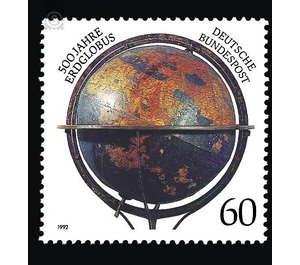500 years earth globe - Germany / Federal Republic of Germany 1992 - 60 Pfennig
Theme: Calender
| Country | Germany / Federal Republic of Germany |
| Issue Date | 1992 |
| Face Value | 60.00 |
| Color | brown white |
| Perforation | K 13 3/4 |
| Printing Type | Multicolor offset printing |
| Stamp Type | Postage stamp |
| Item Type | Stamp |
| Chronological Issue Number | 1500 |
| Chronological Chapter | GER-BRD |
| SID | 190354 |
| In 46 Wishlists | |
With the year 1492 and thus with the anniversary year 1992, two data are combined, which must be important to us today, especially at the time of the emergence of a common European state - beyond its extraordinary significance in art history. The German Martin Behaim, who belongs to the Portuguese court, had the oldest surviving representation of the earth in spherical form made in Nuremberg, and the Italian-speaking Italian Christopher Columbus discovered America. The prior knowledge on which both services are based, again, can not be limited nationally, but the sum of the European knowledge of those days. Martin Behaim was born in Nuremberg in 1459 as the son of the possibly originally from Bohemia patrician family Behaim. Although we know nothing more about his education, it is likely that according to his state of affairs he has taught him everything necessary for the profession of merchant. As was customary in Nuremberg at that time, his schooling was followed by a longer internship abroad, which he took from 1476 to 1484 in the cloth trade in Mechelen and Antwerp. In 1483, a short stay in his hometown is detectable, because he was punished because he had danced at a Jewish wedding in Lent, which he was forbidden as a Christian. Having visited Lisbon at least twice (1479 and 1481), he traveled to this city forever in 1484. Several messages by Portuguese authors of the 16th century (the primary historical sources on Behaim seem to have been lost in the great earthquake in Lisbon in 1755) show that the Nuremberg patrician's son must have played a certain role in solving problems related to expeditions. On his first visit to Lisbon, he is said to have been well acquainted with the research of Johannes Regiomontanus, the founder of modern European astronomy, who lived in Nuremberg from 1471 to 76, thus becoming a member of a commission to improve navigation. Behaim's acquaintance with Christopher Columbus goes back to such secondary sources. However, a significant part of the work of the Nuremberg patrician son at the Lisbon Court, to whom he was particularly attached by marrying the daughter of a lady-in-waiting of the Queen and the Governor of the Azores, Just Hurter, may have been diplomatic missions. According to sources in Nuremberg, Behaim had been knighted when he returned from an expedition to the West African coast, possibly under the command of Diego Coaos in 1484/85. Unfortunately there is no Portuguese evidence for this. From 1491 to 93 Behaim made his way to Nuremberg, where under his guidance the present globe was made. The death of his king Joao II brought Dehaim for his position at court. In 1507 he died impoverished in Lisbon. Behaim's globe, diameter about 51 cm, shows the globe still without the American double continent. Due to a calculation error from antiquity, the Mediterranean Sea and, as a consequence, the adjoining continents of Europe and Africa are far too large. Because of this ancient error, Columbus, who knew these dimensions and compared the distance traveled by him, took islands off the Asian mainland. Recent research has shown that the ball was built by the Nuremberg master craftsman Ruprecht Kolberger from three layers, namely several layers of glued canvas, leather and finally paper. The paper was made by the Nuremberg painter Georg Glockendon d. Ä. with the Weltdarstellung and painted by the writer Gagenhart with writing. The iron frame, whose three-legged lower part was originally made of wood, was provided in 1510 with a then completely novel Horizontring made of brass and set for this occasion on an iron tripod. The Earth's axis could be adjusted variably by two interlocking rings of the meridian circle. The Behaim globe is a "narrative" globe; He carries not only, as usual today, only geographic names, but in addition to numerous miniature paintings and long narrative texts about the respective countries and partly their discovery, as well as information on the historical sources, according to which he was made. Especially the writers Pliny, Strabo and Ptolemy as well as Marco Polo and John de Mandeville are mentioned. Originally, the globe was probably produced as a template for the production of a printed edition, of which, however, has received nothing more. While the work was still in progress, the Nuremberg Council apparently took over the production costs, had the piece worked out in more detail and had it set up in the representative "Regimentstube" of the town hall. Before 1730, the globe came into the possession of the family of its designer Behaim. Not optimally restored at the beginning of the 19th century according to today's concepts, it was loaned to the Germanic National Museum in Nuremberg in 1887, where it remained with a brief interruption, until it was finally bought in 1937 after being bought by the German Chancellor and Nuremberg Mayor Owned by the Germanisches Nationalmuseum, where it is still kept today. (Text: Dr. Johannes Willers, Oberkonservator, Germanisches Nationalmuseum, Nuremberg)


